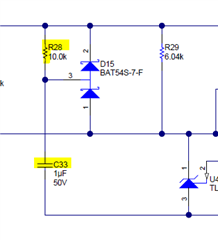Other Parts Discussed in Thread: PMP22301,
Hi,
We built a test coupon based on PMP22301 to generate 24VDC / 20W which worked well with resistive loads.
We moved the design to our board where the TPS23754 provides 24VDC into four LM2596SX voltage regulators. The total current consumption on the 24V rail, into those regulators is < 0.1A.
Each of the LM2596SX devices has about 47uF of input capacitance and 100uF of output capacitance on the outputs of each LM2596SX.
We note that when the TPS23754 is providing 24VDC to the four LM2596SX parts with about 160uF of capacitance the following happens:
1. The TPS23754 circult consumes excess current (> 1A) and the TPS23754 fails
or
2. The TPS23754 burns up its internal GATE_1 pin, which exhibits <10R short to GND
or
3. There is no 24V output from the PoE subsystem, or there are short bursts of 24V on the output (current limit?)
What I feel is happening is that the additional capacitance on the 24V is affecting the stability of the feedback path, causing some oscillations or otherwise.
Can anyone at TI assist with what could be changed on PMP22301 to improve the devices robustness in our application with large capacitance on the 24V output rail?
Thanks.!




